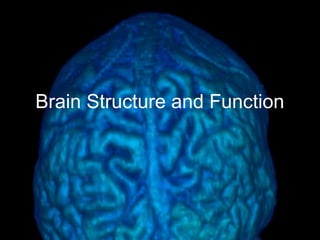The document discusses the structure and function of the human brain. It begins with an overview of the evolution of the brain from the reptilian to paleomammalian to neomammalian structures. It then describes the major parts of the brain including the brainstem, cerebellum, limbic system, and cerebral cortex. Specific areas that control functions like memory, emotion, movement, and the five senses are identified. The document also discusses brain plasticity and lateralization between the left and right hemispheres.






















![Paul Broca [1800s]
• Suggested localization](https://image.slidesharecdn.com/lecture8brainstructure-141015141033-conversion-gate01/85/Lecture-8-brain-structure-23-320.jpg)


















